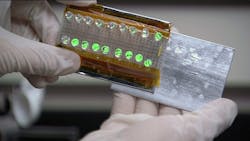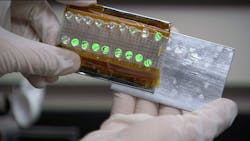>> Website Resources
.. >> Library: TechXchange
.. .. >> TechXchange: Power Management
.. .. .. >> Topic: Energy Harvesting
Researchers at the School of Materials Science and Engineering at the Georgia Institute of Technology are harvesting energy using triboelectric effect technology, or contact electrification. Processor Zhong Lin Wang and his students are taking advantage of the triboelectric effect to harvest small amounts of energy, essentially turning static electricity into something useful. They can power LEDs and other devices using the harvested energy (see the figure).
Related Articles
- Analog Experts Note The Trend Toward Targeted Applications
- Energy-Harvesting IC Plays Into Internet Of Things Ecosystem
- Building A Path To Better Building Efficiency
- ZigBee Will Ensure The Smart Home’s Success
Static electricity is a form of the triboelectric effect. It occurs when some materials are rubbed together and the friction generates static electricity. Walking over a rug on a dry day and touching a metal doorknob is shocking, but not too useful. Georgia Tech researchers can turn this shock into manageable power that could drive sensors and mobile devices.
The approach uses two modes of operation. In one, two materials are brought into contact with each other. In the other, two materials slide against each other. The amount of energy is tiny. But like most energy harvesting technologies, the collection of these small amounts enables useful work to be done, whether it’s lighting an LED or running a microcontroller.
The triboelectric generator has increased power output density by a factor of 100,000. In theory, a square meter could provide 300 W. Originally, the team at Georgia Tech was investigating piezoelectric generators, which use movement and different underlying technology. Triboelectric generators are a laboratory phenomenon now, but practical uses are on the near horizon.
>> Website Resources
.. >> Library: TechXchange
.. .. >> TechXchange: Power Management
.. .. .. >> Topic: Energy Harvesting
About the Author
William G. Wong
Senior Content Director - Electronic Design and Microwaves & RF
I am Editor of Electronic Design focusing on embedded, software, and systems. As Senior Content Director, I also manage Microwaves & RF and I work with a great team of editors to provide engineers, programmers, developers and technical managers with interesting and useful articles and videos on a regular basis. Check out our free newsletters to see the latest content.
You can send press releases for new products for possible coverage on the website. I am also interested in receiving contributed articles for publishing on our website. Use our template and send to me along with a signed release form.
Check out my blog, AltEmbedded on Electronic Design, as well as his latest articles on this site that are listed below.
You can visit my social media via these links:
- AltEmbedded on Electronic Design
- Bill Wong on Facebook
- @AltEmbedded on Twitter
- Bill Wong on LinkedIn
I earned a Bachelor of Electrical Engineering at the Georgia Institute of Technology and a Masters in Computer Science from Rutgers University. I still do a bit of programming using everything from C and C++ to Rust and Ada/SPARK. I do a bit of PHP programming for Drupal websites. I have posted a few Drupal modules.
I still get a hand on software and electronic hardware. Some of this can be found on our Kit Close-Up video series. You can also see me on many of our TechXchange Talk videos. I am interested in a range of projects from robotics to artificial intelligence.


